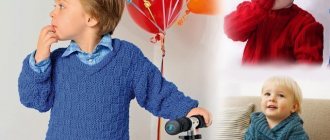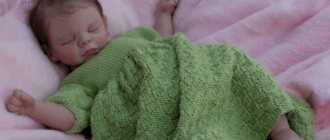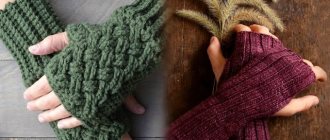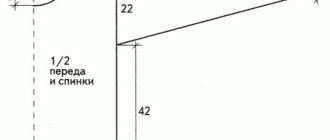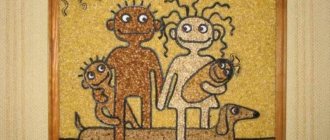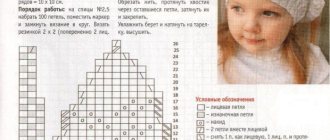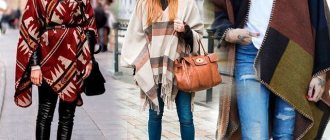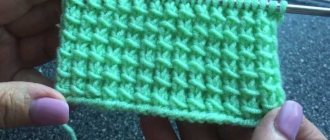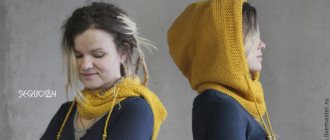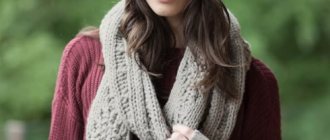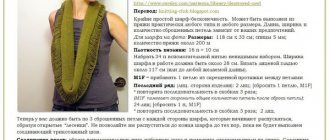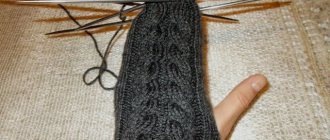Choice of model and color scheme.
To choose the most suitable model, you need to consider some features. A lot depends on the skills of the knitter, as well as on the purpose of the item and the age of the baby.
If you decide to knit for very young children, you should give preference to the simplest models that are multi-functional. This is what determines how a newborn baby will feel in it. In addition, you need to try to knit something that will take a little time to care for. After all, children's clothes are subject to frequent washing, ironing and steaming.
Any mother wants her baby to look fashionable and cute in clothes at any age, so when purchasing materials for work, it is necessary to pay attention only to the highest quality yarns, which should be hypoallergenic and not fade. Another point is that the color of the product should be beneficial for the baby. Therefore, it is better to leave acid yarns for older children.
Yarn selection
It's no secret that many materials cause allergic rashes on the delicate, sensitive skin of a child, not accustomed to harsh environmental conditions. Therefore, the selection of yarn must be taken very seriously.
Doctors recommend giving preference to natural materials. For example, cotton yarn. It provides heat exchange. Also, its distinctive feature is high wear resistance.
An even more gentle option for babies is yarn with the addition of acrylic. This provides additional softness.
For clothing in the cold season, it is worth taking a closer look at non-prickly wool yarn. Firstly, this material retains heat perfectly. Secondly, it does not require frequent washing.
It is worth paying attention to the fact that yarn with sequins, lurex and long pile should never be used for knitting children's clothing for safety reasons.
Once the knitting threads have been selected, you can proceed directly to the process of creating the product.
Material quality
When choosing threads, we focus on tactile sensations. We give preference primarily to cotton or bamboo. Special low-pile yarn of high quality is perfect for knitting.
It is necessary to ensure the absence of villi, as they can cause a reaction, and this is also dangerous for the child’s health if ingested. Another factor that must be taken into account is the softness of the yarn, touching which should cause only pleasant sensations. If the baby does not have allergic reactions, then you can mix natural threads with acrylic ones during needlework.
How to choose yarn for knitting for a newborn
The choice of yarn depends on the season in which the newborn will appear. Below are examples of which threads are best to use for which seasons.
Main types:
- Acrylic . Off-season option for allergy sufferers. Alize, YarnArt, Gazzal, Vita have them. The “Children's Novelty” thread from Pekhorka was once very popular (it is now on sale).
- Merino . Ideal for the cold season. All Turkish, domestic, Italian manufacturers (BBB, Alize, Ornaghi) have this material.
- Half-wool . Also suitable for winter, autumn, spring. A common example of wool blend is the popular Baby Wool yarn from the Turkish manufacturer Alize. Threads with the same name from GAZZAL also appeared in two thicknesses. The manufacturer Pekhorka has yarn with a similar composition “Children's whim”.
- Cotton thread . Good for things for summer or late spring. GAZZAL and Fibranature (Coton Wood) have high-quality organic cotton. Bella yarn from the Turkish manufacturer Alize is very popular.
- Semi-cotton . For clothes for cold summer, off-season. Now there is a very large assortment of yarn for children with this composition, for example: Jeans (YarnArt), Baby Cotton (GAZZAL), Cotton Gold (Alize).
Also, when choosing, you need to focus on your climate. In the middle zone, even in summer it won’t be hot in a semi-cotton cap, and in the southern regions in winter you don’t always need a double merino wool hat.
Tips for beginner needlewomen
The advantage of hand-knitted items is that from one pattern you can produce a whole series of overalls that are completely different from each other. This is due to the variety of knitting tools (knitting needles, crochet hooks, etc.), thanks to which you can create things that differ in pattern, finishing method, quality of material and color scheme.
For a beginning craftswoman, simple models with a small content of elaborate elements that are difficult to execute are best suited. The same requirements apply to knitting variations and patterns.
In order to get a beautiful and easy-to-use item as a result of labor-intensive work, you need to knit only with convenient and previously mastered tools. For example, two models, which at first glance are identical, will be completely different using different knitting methods (stitch stitch and garter stitch).
By arranging elements connected by these basic patterns, even an inexperienced needlewoman will create unique things. For hot summer evenings, openwork inserts made of thin threads are suitable to create a spectacular look. And in the cold months, braids, Aran and Tunisian types are better suited for all reasons.
I would like to give a little advice. To keep your baby cool in a knitted overall in the summer, using thin threads and much larger tools, you can achieve looseness in the knitting.
The process of making a beautiful jumpsuit
Let's take a closer look at how you can knit a jumpsuit for a baby aged six to one and a half years. The size of the finished product is from 68 to 86 centimeters.
For knitting (number three) we will use a pattern such as stockinette stitch. The yarn will be used from wool, weighing no more than 300 grams. You will also need a hook (number 2 or 2.5) and multi-colored or transparent buttons.
We begin to knit the left side of the panties. To do this, we collect loops in quantities from 32 to 41 pieces (depending on the size of the product). To avoid confusion, mark the colored thread at the beginning of the 1st row. After casting on the 1st row, we sew only purl seams - this applies to both legs.
We knit to a certain height (from 16 to 23 cm) and add one loop on the right side, and then we knit to 18 – 28 cm and also add one new loop until we reach 36 – 45 loops. We do all this with stockinette stitch. Now you need to set the piece aside, carefully removing the last row onto a special pin or knitting needle. Using the same pattern, we knit both legs, and then combine them with one knitting needle, marking the middle with a colored thread.
First, we knit the central part of the back on both sides in stockinette stitch, so that the result is 72 - 90 loops (depending on the size). Having knitted 27 - 40 cm, we form the upper part, begin to decrease 1 loop on both sides. Having reached a height of 38 - 54 cm, we make armholes. To do this, close 3 loops 1 time, 2 loops 1 time and 1 loop 3 times on each side, so that 52-70 loops remain. Now we knit the neck and shoulders according to the size of the product (visual instructions can be found in the video).
Now we make the right shelf of the front part, adding 27 - 30 loops to make a total of 50 - 59 loops. We knit the same as the back, decreasing to 49 - 52 loops. Then, at a height of 38 - 54 cm, we make an armhole and get 41 - 50 loops, and then a neckline at a distance of 47 - 65 cm, which we then close on each side. When we reach 49 - 68 cm, we will draw up the shoulder line.
Let's start working with the left front, we will decrease by analogy with the back, we will reach 44 - 56 loops. Then we also make the armholes and get 36 - 48 loops. Having reached a height of 47 - 65 cm, remove from 6 to 3 to the neck on the third knitting needle and close the loops. It’s time to draw the shoulder line at a height of 49 – 68 cm and close the loops that were removed earlier.
Watch the video to see how to make sleeves. Having knitted our unusually cute knitted jumpsuit, we decorate it with unusual buttons. All that remains is to steam the new item.
Among the variety of knitted products on store shelves, only a handmade onesie will look much more interesting and beautiful on a child. At the same time, you will not worry about the quality of the product.
Outfit with a hood
Of course, there are a lot of techniques for knitting children's overalls and it is impossible to tell about everything, but we will offer another, quite common, option with a hood; it will be quite comfortable for your child and very warm.
To begin, cast on 42 stitches on your knitting needles and knit about six centimeters with a regular elastic band. After this, move on to the main pattern (any pattern you want), then add six loops seven times to create bevels. When the product reaches 25 centimeters, this part can be put aside. Next we knit exactly the same piece, but we make all the decreases and increases in a mirror image. We continue to knit as follows: in front, from the middle of the part, both to the left and to the right, close off ten loops. And when the back begins, knit a continuous fabric about forty-six centimeters long.
Related article: Crochet booties-sneakers: master class with description and video
Check the diagram, it should look something like this.
Now let's start knitting the sleeves, here we will work with each element separately. Start from the front on the right side, transfer 16 stitches to the second needle, cast off 6 of them. For the back you will need 48 loops, six of which will need to be closed. Now repeat the same with the left side of the product. When the size of the overalls is 57 centimeters, start knitting the sleeves themselves. Cast on 34 stitches on the knitting needles and knit with an elastic band about six centimeters. You get a sleeve that is approximately 22 centimeters long.
Now we begin to knit the hood. Cast on 80 stitches on the knitting needles and knit through one with an elastic band, about ten centimeters. Then add another 45 stitches on both sides and continue knitting another ten centimeters, and close all the loops. Sew the hood to the overalls. Connect all the parts. The jumpsuit can also be complemented with a pocket or decoration (applique, embroidery, brooch, etc.).
Wash, iron the finished product and you can dress your baby and go for a walk.
